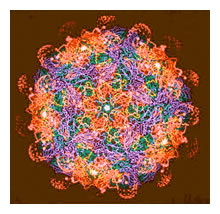 |
||||||||||
Date: August 6, 2025
by Chaya Venkat
Related Article:
Possible Benefits of IVIg

You must have heard the following sound-bite several times by now — the majority of deaths due to CLL result from infections of one sort or another. Patients' compromised immune system makes them vulnerable to a host of pathogens, bacterial, viral, and fungal. Since CLL is a disease of the B-cells of the immune system, it is reasonable to ask the question if the increased susceptibility to infections (both major and minor infections) is due to the inefficiency of the B-cell arm of the immune system. Since the major function of the B-cells is to produce immunoglobins, it is logical to see if there is a connection between decreased immunoglobin levels and infections. That is what the word "hypogammaglobulinaemia" means, reduced levels of immunoglobins (another word is gammaglobulins, same thing), "Ig" for short.
There are three distinct areas of concern here. First, CLL cells are present in such large numbers in advanced stages of the disease that they are likely to crowd out good B-cells in the overall population. It is reasonable to consider if the crowding out effect at high tumor load conditions is the major cause of frequent infections, since there are few good B-cells to do the job, and one would think the CLL cells are not too dependable on that front.
Second, there is the issue of damage to the functioning of the bone marrow due to various chemotherapy regimes that patients undergo. Even when the B-cell numbers are low, as in periods of remission right after therapy, and therefore there is no "crowding out" effect, are there just too few good B-cells that can be made anymore by the body, and is this the major cause of vulnerability to infectious pathogens? In other words, is it the chemotherapy history of the patient that determined risk of infection, not the actual level of tumor load at any given time?
The third scenario is the one we have discussed several times in the past few weeks, situations where we deliberately deplete B-cell populations in the body via a B-cell specific monoclonal antibody such as Rituxan. Remember, B-cells which carry the CD20 marker are targeted by Rituxan, and this is the case whether or not they are good B-cells or CLL B-cells. In the case of patients who undergo regular maintenance regimes of Rituxan, it is possible to see a scenario where there is significant depletion of B-cells of all kinds in the body over long periods of time. Is this a scenario ripe for breeding infections, and do we particularly need to worry about loss of "memory" B-cells that are an integral part of our defenses? Should we be worrying about all those childhood immunizations that are no longer present and able to defend us?
Several of our members have periodic injections of immunoglobins, as a way of correcting very low levels of naturally occurring Ig in their own blood. Ig injections are not cheap, or without discomfort. Some patients have worse side-effects than others. Ig injections depend on processing large amounts of human blood from which they are concentrated, with the inevitable worries about contaminated blood products. And there is also the concern that long term dependence on Ig injections poses its own risk. Some oncologists and hematologists question the therapeutic value of Ig injections. The issue is complex, and there are no clear answers. I have just read a good review article on the subject, which tries to sort out the various risk factors, and their relative importance in determining vulnerability to infections. The article is a detailed statistical analysis of 187 CLL patients. The real value of this article as opposed to others I have seen before is that all of the data is based on patient since 1999, i.e., post monoclonal era. Much of the statistical information prior to the advent of Rituxan and Campath may be suspect, in my opinion, because these two monoclonals have changed the therapeutic options to such a large degree. Same thing goes for the classic overall survival numbers. I am willing to bet that patients diagnosed after Rituxan have significantly longer median survival statistics.
Coming back to this article, the very thorough statistical analysis may make it hard to wade through. But there are important nuggets of information here that should be interesting to all of us. Here are a few of the bullet points:
Bottom line, disease activity (as measured by hemoglobin level, LDH level) and cumulative chemotherapy history have a stronger impact on the risk of severe infectious complications, severely decreased levels of Ig (hypogammaglobulinaemia) was not a risk factor. This would not have been an obvious conclusion.
Just to help out those of you who have not had mind-numbingly boring statistics courses in your life, as you browse through this article, focus on two specific terms used in the Tables. "RR" stands for Risk Ratio. A high value of RR for a given item means that particular item carries a huge risk of infections. For example, in Table-V, Pretreatment regimens has an RR value of 7.6 in its impact on minor infections, whereas hypogammaglobulinaemia (low Ig levels) has an RR of only 0.98. The conclusion then is that prior chemotherapy history has a bigger impact on risk of minor infections than low Ig levels.
Statistics is all about reliability of data. Not a week goes by on Topics without my sounding my nit-picky caveats about quality of data, how certain conclusions cannot be accepted as gospel, perhaps because the sample size was too small, or some other feature of the analysis. Let us take a for example: a data set based on 2 patients who used a particular drug and had a good response from it. This information by itself does not give a high level of confidence that other patients will also do well on this drug. The data set is too small, it could be just happenstance that these two patients got a good response. It says nothing about how the patient population in general will fare on this drug. On the other hand, if the drug company had done their post-marketing monitoring conscientiously, and the data based on thousands of patients says 80% of them responded well to the drug, now you have a conclusion that is worth something. You can reasonably expect that your own chances of getting a good response are about 80%, if there are no other complicating issues involved.
That brings me to the second term you should look for in this paper: it is called "P-Value" or just "P", and it speaks to the statistical validity of the data. A low P-value says the data is "real", and most likely not due to a fluke coincidence. Going back to our Table-V, hemoglobin level and chemotherapy history have P-values of 0.003 and 0.004 respectively, for risk of major infection. These are very respectable P-values, and suggest that the connection between hemoglobin level (a surrogate for tumor load) and chemotherapy history are heavy-duty predictors of major infections. Typically, correlations with P-values higher than 0.01 are not worth much, and a P-value of 0.001 is a slam-dunk conclusion.
What does all this mean in terms of the question I posed in my title? Are Ig injections helpful in preventing infections for patients with low Ig levels in their serum? Based on this study, it would seem they are not, at least not for the majority of patients. As always, the individual case may not fit the broad population statistics, and only you and your doctors can determine if you are one of the patients that does not fit the general statistics. According to this review, there is good reason to consider using pro-active medications to prevent infections as a better strategy than Ig injections, for this patient population. I quote: "In conclusion, disease activity and pretreatment extent have a stronger impact on the risk of severe infectious complications than hypogammaglobulinaemia. Preferably, prophylactic strategies should be evaluated in patients defined by these parameters".
 Enter Keywords: |
———
Disclaimer: The content of this website is intended for information only and is NOT meant to be medical advice. Please be sure to consult and follow the advice of your doctors on all medical matters.
Copyright Notice:
Copyright © 2025-2007 CLL Topics, Inc. All Rights Reserved.
All materials contained on this site are protected by United States copyright law and may not be reproduced, distributed, transmitted, displayed, published or broadcast without the prior written permission of CLL Topics, Inc. You may not alter or remove any trademark, copyright or other notice from copies of the content.
However, you may download and print material from CLLTopics.org exclusively for your personal, noncommercial use.
———
